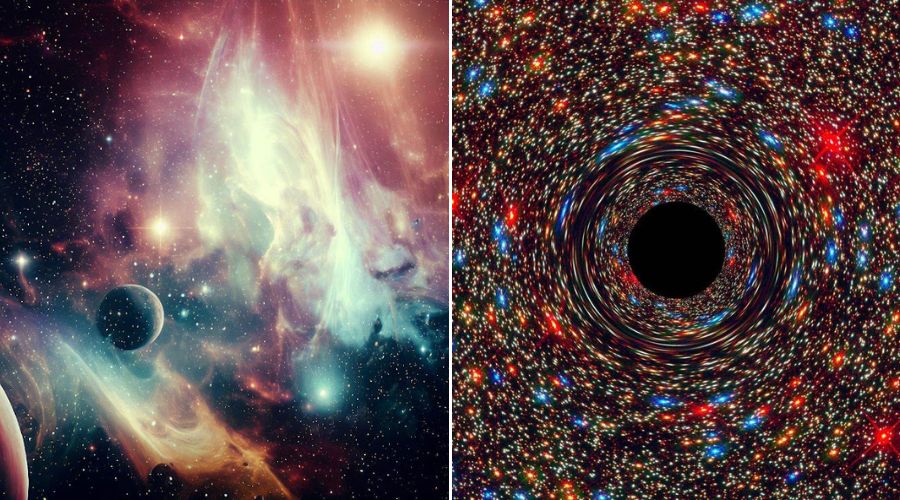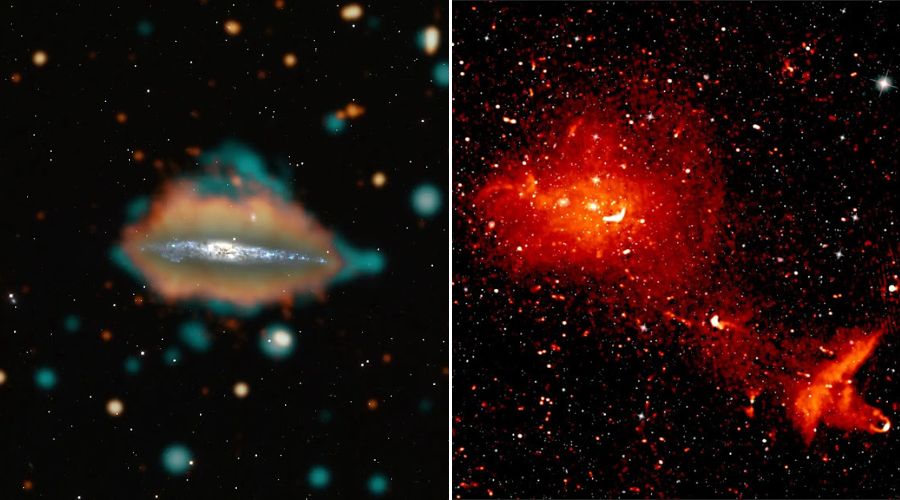
Gliese 876 d, seen here in this artist’s concept, was the first super-Earth discovered around a main-sequence star. The Neptune-like planet orbits a red dwarf star some 15 light-years from Earth.
There are countless worlds beyond our own in the universe’s vast expanse. And among the most intriguing are super-Earths, a type of exoplanet that has captured the attention of scientists and stargazers alike since their initial discovery more than a decade ago.
Super-Earths are defined as planets larger in size than Earth but smaller than Neptune.
“The term ‘super-Earths’ is simply referring to the radius of the planet, and typically refers to something in the range of about 1.5 to 2 times the radius of Earth,” Jessie Christiansen, project scientist of the NASA Exoplanet Archive and research scientist at the NASA Exoplanet Science Institute, tells Astronomy. “They likely have rocky cores but may also have deep water oceans and/or very thick atmospheres. There are a lot of different compositions that are possible.”
The detection of super-Earths has been a major milestone in the hunt for extraterrestrial life. Prior to their discovery, most exoplanets researchers uncovered were gas giants, which are notoriously hard to study for habitability. Now, however, exoplanets are uncovered on almost a daily basis, and current estimates suggest super-Earths make up roughly a third of all exoplanets in the Milky Way.
A sampling of super-Earths
The first super-Earth discovered around a main-sequence star was Gliese 876 d in 2005. The Neptune-like planet orbits a red dwarf star located about 15 light-years from Earth. With a mass 7.5 times that of Earth and a radius just a few times that of Earth, Gliese 876 d was one of the smallest exoplanets discovered at the time. But what really captured scientists’ attention was that the super-Earth was located in its star’s habitable zone, where temperatures are just right for liquid water to exist on a planet’s surface.
In 2022, teams working on NASA’s Transiting Exoplanet Survey Satellite (TESS) discovered a few other particularly fascinating super-Earths orbiting in the habitable zones of their host stars, too.
One such world, TOI-1452 b, is 70 percent larger than Earth and orbits relatively close to its red dwarf host. But despite the planets proximity to its star, researchers think this super-Earth still might be cool enough to host a deep ocean of liquid water — one that could account for as much as 30 percent of the planet’s mass. (For reference, Earth’s ocean accounts for less than 1 percent of our planet’s mass.) Furthermore, because TOI-1452 b is perfectly positioned for future observations by the James Webb Space Telescope, this super-Earth is a prime target for detailed follow-up studies — such as searching for any potential signs of life.

One of the newly discovered super-Earths, TOI-1452 b, might be covered in a deep ocean and could be conducive to life.
Also in 2022, a team led by the University of Montreal discovered two super-Earths orbiting the red dwarf star Kepler-138, located some 218 light-years away in the constellation Lyra. Both planets in this system are believed to be “water worlds.” Although only slightly larger than Earth, these exoplanets are less dense than a rocky planet but denser than the gas giants orbiting our Sun. The most plausible explanation for this is that these planets contain global oceans at least 500 times deeper than those on Earth.
- Home
- /
- News
- /
- Super-Earths and the quest to understand our place in the cosmos
Super-Earths and the quest to understand our place in the cosmosWorlds larger than Earth and smaller than Neptune, super-Earths are absent from our solar system. But evidence suggests they are quite common in the Milky Way.By Jordan Strickler | Published: Monday, March 13, 2023RELATED TOPICS: EXOPLANETS Gliese 876 d, seen here in this artist’s concept, was the first super-Earth discovered around a main-sequence star. The Neptune-like planet orbits a red dwarf star some 15 light-years from Earth.Trent Schindler (NSF)
Gliese 876 d, seen here in this artist’s concept, was the first super-Earth discovered around a main-sequence star. The Neptune-like planet orbits a red dwarf star some 15 light-years from Earth.Trent Schindler (NSF)
There are countless worlds beyond our own in the universe’s vast expanse. And among the most intriguing are super-Earths, a type of exoplanet that has captured the attention of scientists and stargazers alike since their initial discovery more than a decade ago.
Super-Earths are defined as planets larger in size than Earth but smaller than Neptune.
“The term ‘super-Earths’ is simply referring to the radius of the planet, and typically refers to something in the range of about 1.5 to 2 times the radius of Earth,” Jessie Christiansen, project scientist of the NASA Exoplanet Archive and research scientist at the NASA Exoplanet Science Institute, tells Astronomy. “They likely have rocky cores but may also have deep water oceans and/or very thick atmospheres. There are a lot of different compositions that are possible.”
The detection of super-Earths has been a major milestone in the hunt for extraterrestrial life. Prior to their discovery, most exoplanets researchers uncovered were gas giants, which are notoriously hard to study for habitability. Now, however, exoplanets are uncovered on almost a daily basis, and current estimates suggest super-Earths make up roughly a third of all exoplanets in the Milky Way.
A sampling of super-Earths
The first super-Earth discovered around a main-sequence star was Gliese 876 d in 2005. The Neptune-like planet orbits a red dwarf star located about 15 light-years from Earth. With a mass 7.5 times that of Earth and a radius just a few times that of Earth, Gliese 876 d was one of the smallest exoplanets discovered at the time. But what really captured scientists’ attention was that the super-Earth was located in its star’s habitable zone, where temperatures are just right for liquid water to exist on a planet’s surface.
In 2022, teams working on NASA’s Transiting Exoplanet Survey Satellite (TESS) discovered a few other particularly fascinating super-Earths orbiting in the habitable zones of their host stars, too.
One such world, TOI-1452 b, is 70 percent larger than Earth and orbits relatively close to its red dwarf host. But despite the planets proximity to its star, researchers think this super-Earth still might be cool enough to host a deep ocean of liquid water — one that could account for as much as 30 percent of the planet’s mass. (For reference, Earth’s ocean accounts for less than 1 percent of our planet’s mass.) Furthermore, because TOI-1452 b is perfectly positioned for future observations by the James Webb Space Telescope, this super-Earth is a prime target for detailed follow-up studies — such as searching for any potential signs of life.
 One of the newly discovered super-Earths, TOI-1452 b, might be covered in a deep ocean and could be conducive to life.Benoit Gougeon, Université de Montréal, CC BY-ND
One of the newly discovered super-Earths, TOI-1452 b, might be covered in a deep ocean and could be conducive to life.Benoit Gougeon, Université de Montréal, CC BY-ND
Also in 2022, a team led by the University of Montreal discovered two super-Earths orbiting the red dwarf star Kepler-138, located some 218 light-years away in the constellation Lyra. Both planets in this system are believed to be “water worlds.” Although only slightly larger than Earth, these exoplanets are less dense than a rocky planet but denser than the gas giants orbiting our Sun. The most plausible explanation for this is that these planets contain global oceans at least 500 times deeper than those on Earth.
Can super-Earths support life?
Though astronomers are finding an increasing number of super-Earths that could potentially harbor vast oceans of liquid water, searching for life on these worlds is not as straightforward as finding a planet in the habitable zone.
There are many factors that can influence a planet’s potential for habitability, including the density and composition of its atmosphere, the strength of its magnetic field, and its geological activity. But one of the simplest yet most important considerations is the planet’s mass. Super-Earths are thought to have a greater potential for habitability than smaller planets like Mars.
But if they are too massive, they may be covered in a thick layer of gas, which could make it difficult for life to thrive on their surface.
“So far, it’s been hard to learn a lot about super-Earth atmospheres because they are relatively small planets in the grand scheme of things and their atmospheric signatures are commensurately small,” says Christiansen. “Mostly, they seem to have a flat atmospheric spectrum, which could either mean little to no atmosphere, or a very thick, heavy atmosphere that is so dense it’s not allowing any transparency at any wavelengths that would then create spectral features. These super-Earths could also have a very hazy or cloudy atmosphere that is similarly not allowing any transparency.”
Despite the challenge of studying super-Earths, the discovery of these worlds has given scientists more hope that we may one day find life beyond our own planet. The search for life in the universe is one of the great questions of our time, and super-Earths have opened up a whole new realm of possibilities.
- Home
- /
- News
- /
- Super-Earths and the quest to understand our place in the cosmos
Super-Earths and the quest to understand our place in the cosmosWorlds larger than Earth and smaller than Neptune, super-Earths are absent from our solar system. But evidence suggests they are quite common in the Milky Way.By Jordan Strickler | Published: Monday, March 13, 2023RELATED TOPICS: EXOPLANETS Gliese 876 d, seen here in this artist’s concept, was the first super-Earth discovered around a main-sequence star. The Neptune-like planet orbits a red dwarf star some 15 light-years from Earth.Trent Schindler (NSF)
Gliese 876 d, seen here in this artist’s concept, was the first super-Earth discovered around a main-sequence star. The Neptune-like planet orbits a red dwarf star some 15 light-years from Earth.Trent Schindler (NSF)
There are countless worlds beyond our own in the universe’s vast expanse. And among the most intriguing are super-Earths, a type of exoplanet that has captured the attention of scientists and stargazers alike since their initial discovery more than a decade ago.
Super-Earths are defined as planets larger in size than Earth but smaller than Neptune.
“The term ‘super-Earths’ is simply referring to the radius of the planet, and typically refers to something in the range of about 1.5 to 2 times the radius of Earth,” Jessie Christiansen, project scientist of the NASA Exoplanet Archive and research scientist at the NASA Exoplanet Science Institute, tells Astronomy. “They likely have rocky cores but may also have deep water oceans and/or very thick atmospheres. There are a lot of different compositions that are possible.”
The detection of super-Earths has been a major milestone in the hunt for extraterrestrial life. Prior to their discovery, most exoplanets researchers uncovered were gas giants, which are notoriously hard to study for habitability. Now, however, exoplanets are uncovered on almost a daily basis, and current estimates suggest super-Earths make up roughly a third of all exoplanets in the Milky Way.
A sampling of super-Earths
The first super-Earth discovered around a main-sequence star was Gliese 876 d in 2005. The Neptune-like planet orbits a red dwarf star located about 15 light-years from Earth. With a mass 7.5 times that of Earth and a radius just a few times that of Earth, Gliese 876 d was one of the smallest exoplanets discovered at the time. But what really captured scientists’ attention was that the super-Earth was located in its star’s habitable zone, where temperatures are just right for liquid water to exist on a planet’s surface.
In 2022, teams working on NASA’s Transiting Exoplanet Survey Satellite (TESS) discovered a few other particularly fascinating super-Earths orbiting in the habitable zones of their host stars, too.
One such world, TOI-1452 b, is 70 percent larger than Earth and orbits relatively close to its red dwarf host. But despite the planets proximity to its star, researchers think this super-Earth still might be cool enough to host a deep ocean of liquid water — one that could account for as much as 30 percent of the planet’s mass. (For reference, Earth’s ocean accounts for less than 1 percent of our planet’s mass.) Furthermore, because TOI-1452 b is perfectly positioned for future observations by the James Webb Space Telescope, this super-Earth is a prime target for detailed follow-up studies — such as searching for any potential signs of life.
 One of the newly discovered super-Earths, TOI-1452 b, might be covered in a deep ocean and could be conducive to life.Benoit Gougeon, Université de Montréal, CC BY-ND
One of the newly discovered super-Earths, TOI-1452 b, might be covered in a deep ocean and could be conducive to life.Benoit Gougeon, Université de Montréal, CC BY-ND
Also in 2022, a team led by the University of Montreal discovered two super-Earths orbiting the red dwarf star Kepler-138, located some 218 light-years away in the constellation Lyra. Both planets in this system are believed to be “water worlds.” Although only slightly larger than Earth, these exoplanets are less dense than a rocky planet but denser than the gas giants orbiting our Sun. The most plausible explanation for this is that these planets contain global oceans at least 500 times deeper than those on Earth.
Can super-Earths support life?
Though astronomers are finding an increasing number of super-Earths that could potentially harbor vast oceans of liquid water, searching for life on these worlds is not as straightforward as finding a planet in the habitable zone.
There are many factors that can influence a planet’s potential for habitability, including the density and composition of its atmosphere, the strength of its magnetic field, and its geological activity. But one of the simplest yet most important considerations is the planet’s mass. Super-Earths are thought to have a greater potential for habitability than smaller planets like Mars.
But if they are too massive, they may be covered in a thick layer of gas, which could make it difficult for life to thrive on their surface.
“So far, it’s been hard to learn a lot about super-Earth atmospheres because they are relatively small planets in the grand scheme of things and their atmospheric signatures are commensurately small,” says Christiansen. “Mostly, they seem to have a flat atmospheric spectrum, which could either mean little to no atmosphere, or a very thick, heavy atmosphere that is so dense it’s not allowing any transparency at any wavelengths that would then create spectral features. These super-Earths could also have a very hazy or cloudy atmosphere that is similarly not allowing any transparency.”
Despite the challenge of studying super-Earths, the discovery of these worlds has given scientists more hope that we may one day find life beyond our own planet. The search for life in the universe is one of the great questions of our time, and super-Earths have opened up a whole new realm of possibilities.
How do super-Earths form?
The study of super-Earths has also shed light on the formation and evolution of planets, including those in our solar system. Astronomers think that many super-Earths form from the accumulation of rock and ice in the early stages of a star’s life. As these planets grow larger, they may attract gas from their surrounding environment, eventually becoming gas giants if enough material is available.
“We are still learning about how planets smaller than Neptune, four times the radius of Earth, form,” says Christiansen. “One thing that seems to stand out about super-Earths is that some of them may have started as larger planets 2 to 2.5 times the radius of Earth and have lost a chunk of their atmospheres in some way, perhaps by being so close to their host stars that the stellar radiation is blasting the upper atmosphere away.”
Another possibility is that the residual interior heat “leftover from the planet’s formation is pushing outward so strongly that it puffs off the outer layers of the atmosphere,” says Christiansen. “In general, we think the initial process is the same — accretion of material in a protoplanetary disk (a rotating circumstellar disk of dense gas surrounding a young newly formed star) that builds up until it is a rocky planet — but that subsequent process sculpts and evolves the planet properties into what we see today.”
The discovery of super-Earths is a momentous achievement for both science and humanity. They offer the possibility of liquid water on their surfaces and the potential for habitability, providing a place where life might be able to take hold.
And even if super-Earths don’t harbor life, their study has given astronomers important insights into the formation and evolution of all planets. Super-Earths challenged our understanding of what types of worlds planetary systems should have. Their discovery reminded us of the vast and diverse nature of the universe, which is always helpful in motivating us to continue investigating our place in the cosmos.







